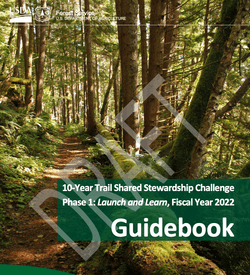




Phase 1: Launch and Learn, Fiscal Year 2022 Guidebook
Why Do We Need a Trail Challenge? Despite the great work happening in support of trails, workload demands continue to outpace the capacity of agency staff, partners, and volunteers. To address these shortcomings, the Forest Service has issued a 10-year Trail Challenge. It focuses the collective energy and resources of the trail community on actions resulting in greater collective capacity to manage and maintain trails, as well as more miles of trails that are well-designed, well-maintained, and well-suited to support recreation use today and into the future.

With 160,000 miles of trails, the Forest Service manages the Nation’s largest trail system, including thousands of miles of nationally designated scenic, historic, and recreation trails. National Forest System trails bring physical, spiritual, and mental benefits to communities and individuals nationwide. These trails are also used as tools to protect natural and cultural resources and support the U.S. Department of Agriculture Forest Service’s core values of service, conservation, interdependence, diversity, and safety.
Trails are powerful economic generators, contributing billions of dollars each year to the economy and supporting thousands of jobs in outdoor recreation and tourism. Continued maintenance of these resources is dependent on the shared stewardship of agency employees, Indian Tribes, partners, volunteers, contractors, permittees, and communities—collectively known as the “trail community.” We are reliant on one another—people from all walks of life and diverse perspectives—to steward trails for the benefit of all people.
Why Do We Need a Trail Challenge?
Despite the great work happening in support of trails, workload demands continue to outpace the capacity of agency staff, partners, and volunteers. For example, many National Forest System trails are legacy trails that were not well-designed or well-located. These unsustainable trails—and the proliferation of unauthorized or user-created routes—drain agency resources.
There are further barriers to efficient trail management, including increasing use levels, changing technology and use patterns, damage from natural disasters, and out-of-date data collection methods and reporting processes. Gaps in skills, training, and staffing exacerbate the situation. Employees also recognize staff and user groups often don’t reflect an area’s demographic composition. Many districts and partners struggling with these issues are developing their own solutions, resulting in duplication of effort or inconsistencies.
To address these shortcomings, the Forest Service has issued a 10-year Trail Challenge. It focuses the collective energy and resources of the trail community on actions resulting in greater collective capacity to manage and maintain trails, as well as more miles of trails that are well-designed, wellmaintained, and well-suited to support recreation use today and into the future
Attached document published March 2022
Launching the USDA Forest Service’s 10-year Trail Shared Stewardship Challenge in the Eastern Region
posted Oct 10, 2023
This report was produced by American Trails in partnership with the USDA Forest Service USFS Eastern Region. The report and the engagement process that it chronicles represent the kind of cooperation that the 10-Year Trail Shared Stewardship calls for. It has been a pleasure to share in this experience and launch the Trail Challenge in the Eastern Region!
ON FIRE: The Report of the Wildland Fire Mitigation and Management Commission
posted Oct 2, 2023
The wildfire crisis in the United States is urgent, severe, and far reaching. Wildfire is no longer simply a land management problem, nor is it isolated to certain regions or geographies. Across this nation, increasingly destructive wildfires are posing ever-greater threats to human lives, livelihoods, and public safety.
Trails and Resilience: Review of the Role of Trails in Climate Resilience and Emergency Response
posted Apr 12, 2023
Trails are often overlooked as elements of essential infrastructure for a resilient transportation system.1 In emergencies where other transportation facilities are shut down or inaccessible, people may use trails to get where they need to go.
2023 Legacy Trails Program Grant Awardee Portal
posted Apr 3, 2023
Below you will find documents that may be useful as you prepare your invoices.
487 views • posted 03/21/2022